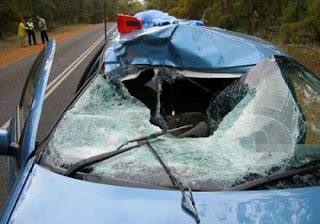Though the protected bars on the front of rural vehicles is called a bull bar, it was originally designed to stop damage from hitting a kangaroo. These animals are as common as muck in Australia. Indeed, they are a native pest if ever there was one. Countless kangaroos invade farms all the time eating grass meant for food animals and drinking water pumped out of the ground.
It is unusual for a driver to hit a wandering cow. Because they are valuable they are generally safely penned in. On the other hand, kangaroos wander freely. If they can't jump over a fence they will run through it. Several years ago I saw the remains of a kangaroo paw hanging from a fence wire. Obviously, the animal had survived and bounded on his way.
Volvo Australia is studying kangaroo behavior on the roadside. They intend to fit a radar sensor to cars that will scan the road ahead. When a kangaroo is detected directly ahead within contact range the brakes will be automatically applied to a vehicle.
If Volvo is successful it will dramatically reduce insurance costs. Over 20,000 kangaroos are hit annually in Australia. It is like hitting a brick wall. Some vehicles are written off; there is so much damage.
◆ Technology by Ty Buchanan ◆
#kangaroos #bullbar #bull #cows #road #highway #danger #damage #insurance #cost
●
. . . . . . . . . . . . . . . . . . . . . . . . . . . . . . . . . .
volvo australia kangaroos bull cows road highway danger damage articles news information data search technology anthropology evolution science genetics biology politics history health
KANGAROO DANGERvolvo australia kangaroos bull cows road highway danger damage articles news information data search technology anthropology evolution science genetics biology politics history health
#kangaroos #bullbar #bull #cows #road #highway #danger #damage #insurance #cost










